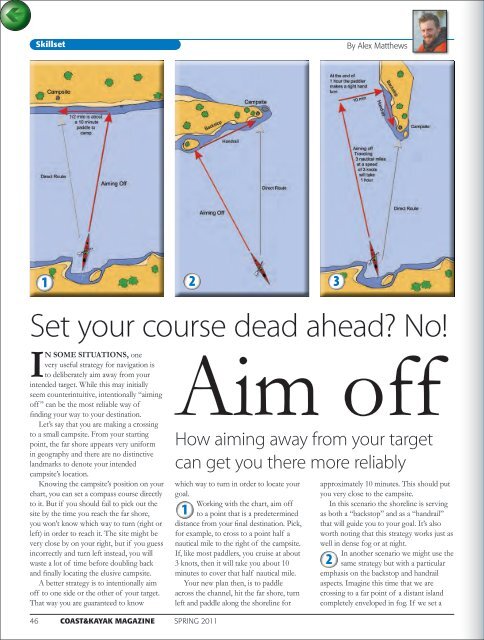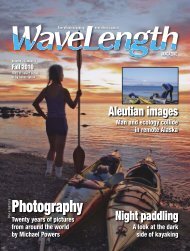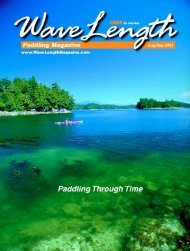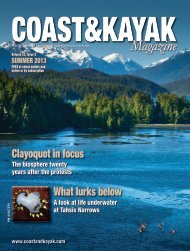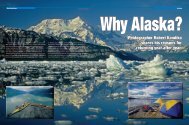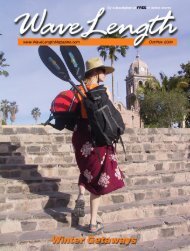a kayak - Wavelength Paddling Magazine
a kayak - Wavelength Paddling Magazine
a kayak - Wavelength Paddling Magazine
Create successful ePaper yourself
Turn your PDF publications into a flip-book with our unique Google optimized e-Paper software.
Skillset<br />
By Alex Matthews<br />
1 2<br />
3<br />
Set your course dead ahead? No!<br />
IN SOME SITUATIONS, one<br />
very useful strategy for navigation is<br />
to deliberately aim away from your<br />
intended target. While this may initially<br />
seem counterintuitive, intentionally “aiming<br />
off ” can be the most reliable way of<br />
finding your way to your destination.<br />
Let’s say that you are making a crossing<br />
to a small campsite. From your starting<br />
point, the far shore appears very uniform<br />
in geography and there are no distinctive<br />
landmarks to denote your intended<br />
campsite’s location.<br />
Knowing the campsite’s position on your<br />
chart, you can set a compass course directly<br />
to it. But if you should fail to pick out the<br />
site by the time you reach the far shore,<br />
you won’t know which way to turn (right or<br />
left) in order to reach it. The site might be<br />
very close by on your right, but if you guess<br />
incorrectly and turn left instead, you will<br />
waste a lot of time before doubling back<br />
and finally locating the elusive campsite.<br />
A better strategy is to intentionally aim<br />
off to one side or the other of your target.<br />
That way you are guaranteed to know<br />
Aim off<br />
How aiming away from your target<br />
can get you there more reliably<br />
which way to turn in order to locate your<br />
goal.<br />
1<br />
Working with the chart, aim off<br />
to a point that is a predetermined<br />
distance from your final destination. Pick,<br />
for example, to cross to a point half a<br />
nautical mile to the right of the campsite.<br />
If, like most paddlers, you cruise at about<br />
3 knots, then it will take you about 10<br />
minutes to cover that half nautical mile.<br />
Your new plan then, is to paddle<br />
across the channel, hit the far shore, turn<br />
left and paddle along the shoreline for<br />
approximately 10 minutes. This should put<br />
you very close to the campsite.<br />
In this scenario the shoreline is serving<br />
as both a “backstop” and as a “handrail”<br />
that will guide you to your goal. It’s also<br />
worth noting that this strategy works just as<br />
well in dense fog or at night.<br />
2<br />
In another scenario we might use the<br />
same strategy but with a particular<br />
emphasis on the backstop and handrail<br />
aspects. Imagine this time that we are<br />
crossing to a far point of a distant island<br />
completely enveloped in fog. If we set a<br />
46 COAST&KAYAK MAGAZINE SPRING 2011


